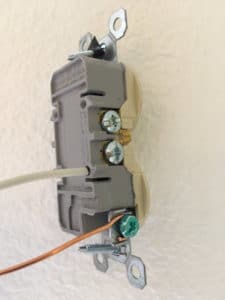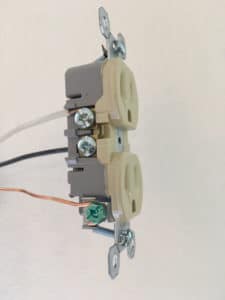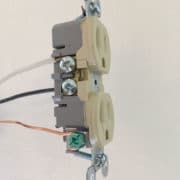Understanding Backstabbing and the Potential Effects of Backstabbing Receptacles and Switches
Have you ever been betrayed by someone you thought was your friend? That’s called backstabbing and it’s the only definition most people know. But there’s a good chance some (or all) of your receptacles and switches are “backstabbed” and at some point you will be betrayed.
What does “backstabbing” or “stablocking” mean from an electrical perspective? And why would anyone other than an electrician care?
Let’s start by defining “backstabbing”. Backstabbing is a method of connecting electrical wires to a receptacle (or switch) allowing it to function. For the remainder of this article I will refer to receptacles and switches as “devices”.
 Here is an angled view of the backside of a device. You can see there are 4 little round holes – 2 on each side. The picture shows a wire that has been “backstabbed” into one of the 4 holes. This is a quick and easy way to connect the hot and the neutral wires to the device: strip the insulation jacket (“strip”) and stab them into these holes. If you are connecting additional devices “downstream”, then all 4 holes are used – 2 holes for the hot and neutral wires coming in and 2 holes for the hot and neutral wires going out to the next downstream device. An experienced electrician can strip and stab 4 wires into the back of a device in a matter of 20 to 30 seconds.
Here is an angled view of the backside of a device. You can see there are 4 little round holes – 2 on each side. The picture shows a wire that has been “backstabbed” into one of the 4 holes. This is a quick and easy way to connect the hot and the neutral wires to the device: strip the insulation jacket (“strip”) and stab them into these holes. If you are connecting additional devices “downstream”, then all 4 holes are used – 2 holes for the hot and neutral wires coming in and 2 holes for the hot and neutral wires going out to the next downstream device. An experienced electrician can strip and stab 4 wires into the back of a device in a matter of 20 to 30 seconds.
 Now let’s look at a side view of the device. You can see there are a total of 4 screws – 2 on each side. These screws are also called terminals and are an alternative (and better) way of connecting electrical wires to a device. There are 2 different ways of connecting the hot and neutral wires to the terminals – either directly or through pigtailing. Pictured here is a direct connection. For the purposes of this article what is important is that regardless the method used, when the insulation jackets are stripped, a significant portion of wire is wrapped around the terminal. The terminal is then tightened allowing for a long-term, secure connection to the device. The time it takes an experienced electrician to wrap 4 wires, and tighten 4 terminals, or to make a pigtail, is minimal – approximately 2 or 3 minutes.
Now let’s look at a side view of the device. You can see there are a total of 4 screws – 2 on each side. These screws are also called terminals and are an alternative (and better) way of connecting electrical wires to a device. There are 2 different ways of connecting the hot and neutral wires to the terminals – either directly or through pigtailing. Pictured here is a direct connection. For the purposes of this article what is important is that regardless the method used, when the insulation jackets are stripped, a significant portion of wire is wrapped around the terminal. The terminal is then tightened allowing for a long-term, secure connection to the device. The time it takes an experienced electrician to wrap 4 wires, and tighten 4 terminals, or to make a pigtail, is minimal – approximately 2 or 3 minutes.
Backstabbing a device is easier and considerably faster. When an electrician wires a new home, he/she is likely to connect 40 or 50 receptacles and another 20 – 30 switches in an average sized home. Assuming that, on average, backstabbing saves 2 minutes per device installed, the electrician will save a total of 2 to 3 hours of labor, per new home, by backstabbing. If the electrician is working in a housing development, this savings is multiplied many times over.
What is the downside of backstabbing? Inside the small holes are a piece of metal called a “blade” that makes the connection between the wire and the device. Compared to wrapping the electrical wire around a screw, the connection between the blade and the wire is extremely minimal – only a tiny surface area of the neutral or hot wire is making contact with the blade. As the device gets used, it warms and cools. The device gets jostled slightly with each use. Over time, these activities can cause the wire to lose connection with the blade. In Florida, with so much humidity, the wire only needs a very small amount of corrosion to lose connectivity to the blade. The downside? Only one wire needs to lose contact for the device to stop working. Not only does that device become inoperable – all downstream devices become inoperable. This might impact an entire room or more.
For you do-it-yourselfers, there are some issues to consider before making a repair. Imagine you go into your living room and turn on your reading light. It doesn’t work. You decide you are going to fix the problem yourself by replacing or rewiring the receptacle (don’t forget to turn off the CORRECT breaker before pulling the device or you may be in for a shock!). You pull the device, you do the rewiring (and turn the breaker back on). It still doesn’t work. Now perhaps you are scratching your head. You may not have correctly wired the device, but more likely what has happened is there is another “upstream” device that was backstabbed and has lost connectivity. You will need to identify which is the offending device and rewire or replace it.
New construction in Florida is booming. If you are building a new home, you should consider asking your builder to use the terminals on the devices and forego the backstabbing. In the long run, the extra investment will pay dividends.



Leave a Reply
Want to join the discussion?Feel free to contribute!